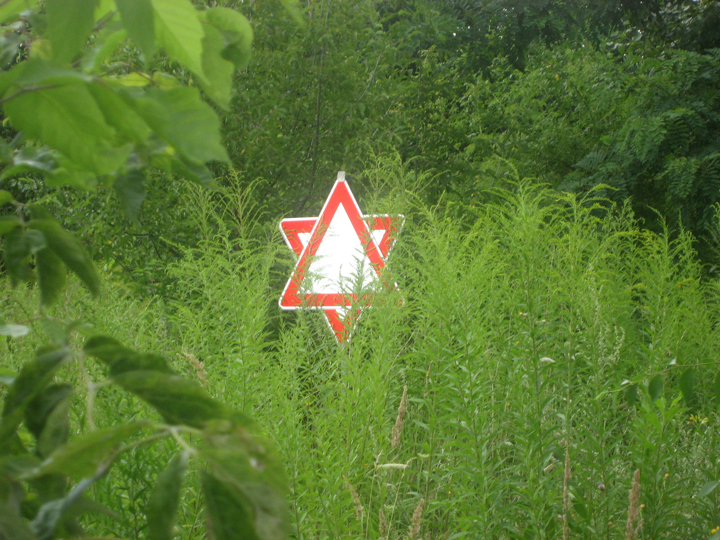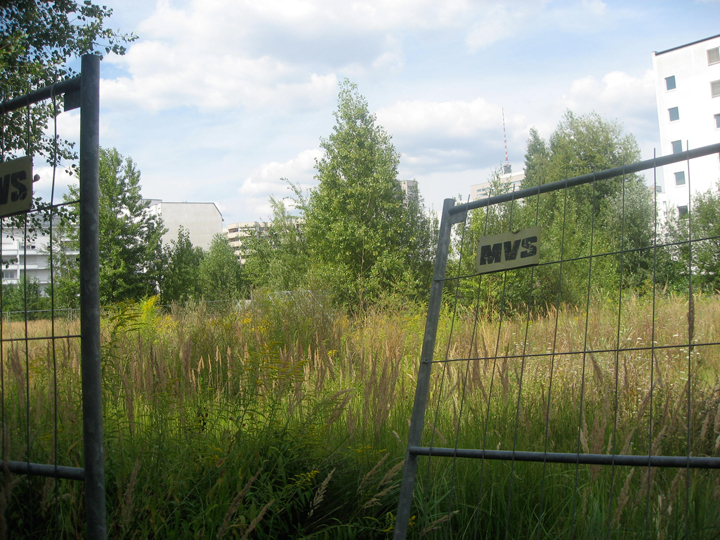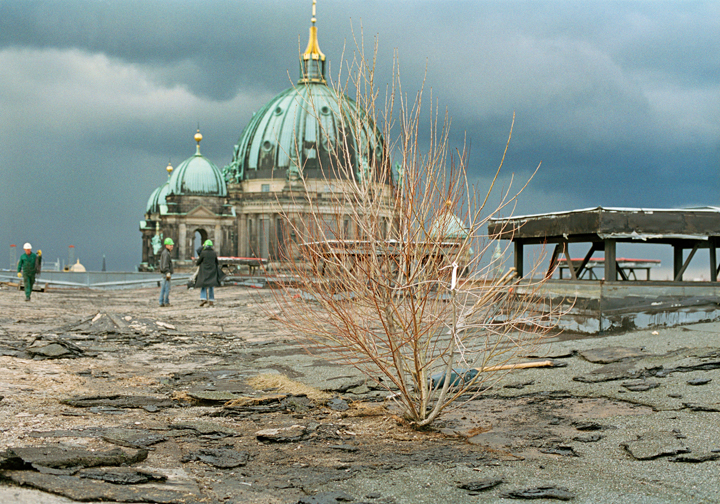

In appropriating the vacant lots of the wasteland and creating art installations on the margins, the artist collective that formed the Sculpture Park created a space that counteracts this surfeit of memorialization and commodification of Jewish memory in Berlin today. In addition to the Star of David installation, another striking contribution to the genre of Land Art was Ulrike Mohr's series of installations Restgrün and Neue Nachbarn, which were part of the Fifth Berlin Biennial in the Sculpture Park's 2008 exhibit Spekulationen. In the first of this series of projects, Mohr transplanted trees that had been found growing on the roof of the Palace of the Republic as it was awaiting demolition. The Palace of the Republic, built in the mid- 1970s to house the parliament of the German Democratic Republic as well as art galleries, theaters, restaurants, a bowling alley, and a discotheque, stood on the site of the former Stadtschloss (City Palace), damaged in the war. The trees found on the rooftop were spontaneous vegetation created by a mix of bitumen, polystyrene, and concrete. Within a short period of time, moss, lichen, various grasses, and trees germinated. On April 4, 2006 demolition work on the Palace was stopped for one day and the roof's scrubby, self-seeded trees were identified botanically, labeled, and dug out, at the precise moment at which the Palace of the Republic was demolished, and replanted in the Sculpture Park in exactly the same position as on the roof of the Palace. Mohr marked the trees transplanted to the Sculpture Park with Palace of the Republic medallions and small plastic botanical classifications pushed into the ground. Otherwise, "the trees quietly and symbiotically blended in with their new neighbors, wild trees and vegetation, who similarly sprouted from cracks after the fall of the Wall."

Mohr's next project was to transplant the five trees to the roof of the Neue Nationalgalerie, built by Mies van der Rohe in former West Berlin, with the constellation and placement of the trees corresponding to the corner points of Mies van der Rohe's main hall, thus establishing a new link between east and west. The Prussian Cultural Ministry forbade it, yet Mohr was able to create a documentary exhibit of the trees in the main hall of the museum. Mohr had planned to keep the trees permanently in the Sculpture Park, but because of new building regulations she had to uproot the trees after the Biennale in the fall of 2008; they were transplanted in the "Depot" of the Baumschule Späth in Berlin.
Finally, Mohr proposed an installation, Exile, in which the self-seeded, uprooted and transplanted trees, now conceptualized as "Palace Tree Refugees," (Palastbaumflüchtlinge) would be transported to the Villa Aurora, the former home of German Jewish émigré writer Leon Feuchtwanger, in Pacific Palisades, California. Funding and other practical considerations forced her to abandon this project. A Los Angeles exile for the "Palace Tree Refugees," which would be brought not only to Los Angeles but more specifically, to the former home of Feuchtwanger, evokes the trees as exilic German Jews, truly "rootless cosmopolitans." For Mohr, Los Angeles is a site of German Jewish refugee history, but also a city that is in flux between nature and culture; city and desert; a place of Land Art and site specificity, a place of rampant and fast growth, a city with a scarcity of water resources that has the most stringent regulations for importing living plants. Into this landscape of deprivation, immigration, urban entanglement, and German Jewish history Mohr wanted to place the "Palace Tree Refugees."
What does this project say about the ongoing debates about the notion of space and Heimat in German-Jewish culture today? Mohr's installations and (failed) proposals, in which vegetation erupts in the entanglement between Jewish and German spaces, suggest the rhizomatic spread, or germination, of Jewish to German to Jewish, and insists that the German is always already Jewish. Seeking to transport the "Palace Tree Refugees" from East Berlin to the heavily marked Jewish spaces of the former wall zone, with a stop at the modernist mecca of the Mies van der Rohe museum (occupying another border zone between east and west) and then to Feuchtwanger's exile residence in Los Angeles, Mohr uproots dominant ways of thinking about Jewish spaces and public art in a city that is replete with debate about Jews and the public sphere.
Most importantly, Mohr's project forces us to contemplate Jewishness in a major metropolis that is in a complex dialogue with New York, Tel Aviv, and Los Angeles, and that plays a vital role in the shaping of new Jewish life in cities to the east of Berlin: Krakow, Vienna, Budapest, and Vilna, as these cities have been emerging from their own complex historical and cultural ruin. Mohr's "refugee trees," rootless cosmopolitans in their own right, are not attempting to re-root any notion of authentic Jewishness, whatever that would mean, in the ruins of German-Jewish history. Rather, Mohr's project is a way of thinking about contemporary German-Jewish urban space and historical spaces of memory as part of the complex ordering of the private, public, and sanctified spaces of urban Jewish culture.

